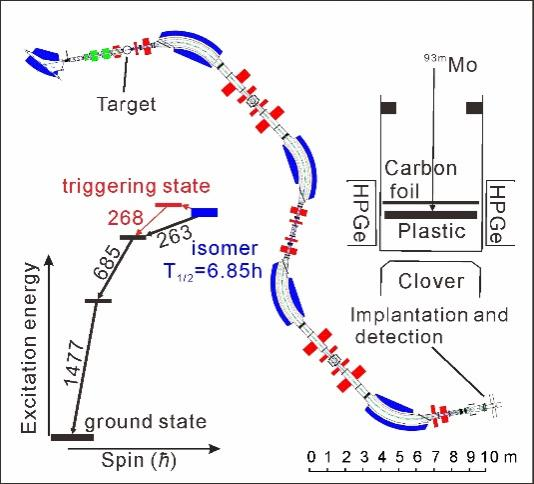Reviewed by Alex SmithJun 27 2022
At the Radioactive Ion Beam Line in Lanzhou (RIBLL), China, a “black” environment was developed to search for a faint flash of light as proof of isomer depletion. For nuclear excitation by electron capture (NEEC), which uses nuclear energy stored in long-lived isomeric states, such depletion is necessary.
 Experimental setup in the present work. The secondary beam line RIBLL is shown with the corresponding distance scale. In the lower left area, the isomer depletion of 93mMo is sketched together with the spontaneous decay of the long-lived isomer. The setup for implantation and detection is shown in the upper right area. Image Credit: Physical Review Letters
Experimental setup in the present work. The secondary beam line RIBLL is shown with the corresponding distance scale. In the lower left area, the isomer depletion of 93mMo is sketched together with the spontaneous decay of the long-lived isomer. The setup for implantation and detection is shown in the upper right area. Image Credit: Physical Review Letters
Nevertheless, there was no indication of isomer depletion in the independent trial. The first reported experimental detection of NEEC in 2018 has been called into question after findings were published in Physical Review Letters on June 17th, 2022. The NEEC probability was found to be less than 2×10–5.
One atomic nucleus can store millions of electron volts. As a result, extended storage times, large energy densities, and great stability make long-lived isomers with high excitation energies suitable as energy storage materials.
However, it is very difficult to intentionally regulate the energy release mechanism. According to scientific consensus, isomer depletion—or stimulating the isomer to an adjacent excited state that swiftly decays to the ground state—will be used to quickly release isomeric energy. Scientists have suggested several techniques, with NEEC garnering the most attention.
With a measured excitation probability of 1.0(3)%, which is almost nine orders of magnitude higher than the theoretical expectation, the first experimental observation of NEEC was announced in 2018.
Later, scientists noted a potential overestimation caused by high gamma background contamination. This remark and the subsequent response sparked a heated discussion about the veracity of the reported NEEC observation and demanded confirmation from a different, independent measurement.
The argument centered on whether the researchers took the impact of the strong gamma background seriously enough.
Researchers from the Institute of Modern Physics (IMP) of the Chinese Academy of Sciences (CAS) and its associates employed an isomer beam to reexamine isomer depletion while avoiding contamination from the heavy gamma background. The experiment was carried out in RIBLL, which is located at Heavy Ion Research Facility, Lanzhou.
Our experiment was designed to escape from the gamma background. In the previous work, researchers searched for the scarce special photons in a harsh light, like seeking a firefly in sunshine. For a refined survey, we drove it into the dark.
Song Guo, Researcher, Institute of Modern Physics, Chinese Academy of Sciences
To analyze the isomer depletion during the slowing-down phase of the ions in a low gamma-ray background environment, 93mMo residues were developed at the primary target site and delivered to the end of RIBLL.
At such a low gamma background, the researchers did not see isomer depletion. It was found that the excitation probability was less than 2×10–5, which is considerably smaller than the previously reported probability and in line with theoretical projections.
Although the two studies were set up differently, according to Guo, “the gamma backdrop is still the most noticeable element.”
One referee at the Physical Review Letters stated, “The experiment they report is demonstrably superior to the earlier work in that the 93mMo nucleus formed in a fusion evaporation reaction was separated from the incident beam via traversal through the RIBLL separator. This allows for a low-background signal to be obtained that conclusively limited the NEEC rate.”
It is important to note that this is the first time an isomer beam has been used in NEEC research. It is a potential method for researching isomer depletion due to the greatly improved experimental sensitivity.
The National Natural Science Foundation of China, the Key Research Program of CAS, and the National Key R&D Program of China provided support for this study.
Journal Reference:
Guo, S., et al. (2022) Probing 93mMo Isomer Depletion with an Isomer Beam. Physical Review Letters. doi:10.1103/PhysRevLett.128.242502.